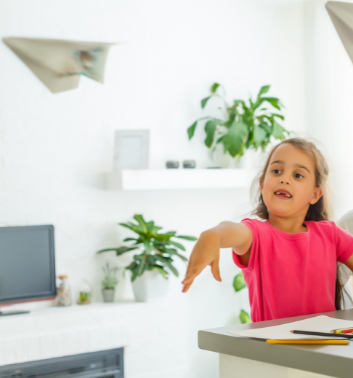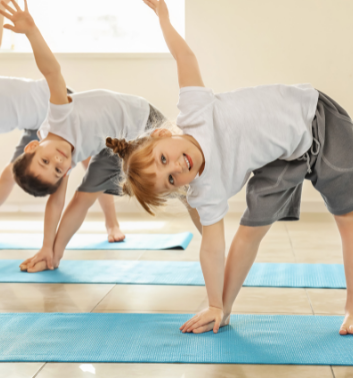Fun Activities for Kids to Get Active at Home; The Complete Guide to Physical Activity for 5-12 Year-Olds at Home
Doing daily exercise is an easy and effective way to help your child to feel more upbeat and keep them healthy. But if you don’t have a garden or have limited space, you might think your options are restricted.
However, there are lots of exciting ways to get moving at home with your children, many of which revolve around creative play.
In this article we will look at:

How much physical activity does my 5-12 year-old need?
Children and young people in this age bracket should take part in moderate to vigorous physical activities for at least 60 minutes every day.
Children should take part in a variety of types and intensities of physical activity to develop movement skills, muscles and bones.
Reduce the time they spend sitting or lying down and try to break up long periods of inactivity.
Benefits of physical activity in kids
Exercise brings a host of benefits to children’s physical and mental health:
- Improves fitness
- Builds a stronger heart, bones and healthier muscles
- Encourages healthy growth and development
- Increases concentration
- Improves self-esteem
- Bonding activity between parent and child
- Can improve academic attainment
- Improves posture, balance and co-ordination
- Assists problem-solving abilities
- Improves communication
- Reduces stress and boosts mood
- Encourages a better night’s sleep
- Regulates emotions
- Encourages interaction with others

16 fun activities for kids at home
The only limit to keeping children active at home is your imagination!
You don’t need specialist equipment, a large garden or a budget. Just make sure the space is free from hazards like slippery surfaces or sharp edges, and children will intuitively find a way to move.
These ideas are simple and cost-effective ways to help to keep your child active and have endless fun, even if you’re stuck inside!
Fun ideas that challenge
Indoor obstacle course
Creating your own indoor obstacle course using everyday items is a brilliant way for your child to challenge themselves physically. The course can be adapted to suit your child’s age and level of development and is guaranteed to sharpen co-ordination skills and problem-solving.
Crawling under a tunnel of chairs, making a ‘tightrope’ of cushions or throwing toilet paper rolls into a cardboard box are just some of the ways children can develop hand-eye co-ordination and balance. Try walking with a beanbag on their head, jumping in and out of a hula hoop or following a maze created out of books – the possibilities are endless!
Indoor treasure hunt
A scavenger hunt is a fun indoor activity and a mentally and physically stimulating way to entertain kids at home. Their naturally inquisitive brains are well suited to solving clues or hunting for bounty and the complexity of the hunt can be adapted to suit the child’s age.
At the most basic level, draw a map of either the ground floor or a particular room in your house. Mark on furniture and doors and signal where the treasure is located with an ‘x marks the spot’.
To make it more complicated, create a quirky clue to find each location, with another clue waiting at that spot (rhyming clues have added appeal). Place a treat at the final destination and the kids will love using their initiative to solve the clues. This is an empowering self-directed activity, which helps the child to learn sequencing along with racing around the house in search of the treasure!
Paper planes
Turning a piece of paper into a toy is a fascinating process for children, who will feel a sense of achievement in making their own aeroplane.
Plus, they are an excellent way to introduce concepts like experimentation and aerodynamics.
There are many different types of paper aeroplanes to make but start with the classic dart shape. Give each plane a test-flight – which is an opportunity to explain the basic principles of aerodynamics by showing children how each paper aeroplane’s design affects its trajectory. A great learning opportunity.
Once made, use the planes for a variety of different games such as aeroplane races, a distance-throwing competition or target hitting activities.

Walk the plank!
Little pirates of all ages will love having a chance to walk the plank!
Set up a plank out of masking tape or string, or, if safe to do say, lay a sturdy plank of wood low to the ground, and encourage your child to walk along it without falling off.
Stimulating and challenging, the game is ideal for developing core strength and improving balance and co-ordination.
Encourage each plank walker by cheering from the sidelines. Or, to make it more, difficult for older kids – and if safe to do so – try walking the plank wearing a blindfold.
High energy ideas
Kitchen disco
Kitchen discos shimmied to fame during lockdown, when families found them an energetic way to have fun together.
Compile a playlist of your child’s favourite songs, encourage them to play dress ups in party clothes and throw on some glow sticks if you have some.
Dim the lights and turn up the volume. It’s a great way to keep the kids entertained and the whole family will happily dance for ages, practising new moves and moving their bodies to the music. Parental participation is optional but guaranteed to cause even greater enjoyment for all movers and shakers involved!
Balloon volleyball
If you have any balloons left over from a children’s party, use them for a high-octane game of balloon volleyball.
Set up an indoor volleyball court by bisecting the living room or kitchen with a makeshift net. Your child stands on one side, you stand on the other and the objective is to volley the ball back and forth while keeping the balloon airborne on your side of the court. Award a point to the winner of each rally.
If you don’t have the space to create a court, simplify the game by seeing how long you can can keep the volleyballoon in the air. Time it and challenge your child to keep it airborne for longer every time they try. It’s great for co-ordination and cardiovascular exercise, giving the heart a healthy workout at the same time as the mind.
Indoor pool
Ever wanted your own indoor swimming pool? Improvise by bringing your kids paddling pool indoors to form a makeshift ball pit!
Make sure it’s clean and that there’s sufficient space indoors beforehand. Once indoors, fill it up with balls, balloons or soft toys and convert it into your very own ball pit. It’s excellent for jumping and launching into (just set it up away from hazards or sharp edges) and when it’s time to clear up kids love practising their aim by throwing the balls back in.
Kids yoga
The benefits of yoga in children are widely documented. From alleviating anxiety and boosting self-esteem to increasing body awareness and flexibility, yoga is a grounding activity that is good for physical and mental health.
Yoga mats aren’t essential. Simply clear a space in front of you and launch a kids yoga tutorial online. Cosmic Kids have over 1.25 million subscribers on YouTube and produce themed or seasonal yoga videos which are highly engaging and straightforward to follow.

Party games – great for playdates!
Get the party started at your house with some fun and energetic party games. From musical chairs and musical statues, which require good listening, balance and co-ordination skills, to the exhilarating ‘floor is lava’ game, which requires players to get both feet clear of the ground every time someone shouts ‘floor is lava’, fun games are so entertaining kids barely realise they’re keeping active at the same time.
It’s easy to modify favourite games too. Make your own version of the party classic pass the parcel by introducing an active twist. Write a series of physical challenges onto pieces of card. Wrap one challenge card into each layer of the parcel along with a healthy treat.
As each child opens a layer they have to act out the activity challenge (10 star jumps, crab walk across the room, bunny hop to the front door and back for example) before they can claim their healthy snack.
Spoon race
There’s no disputing the fun of a simple egg and spoon race, where kids walk or run from one point to another holding a spoon with an egg balanced atop, trying not to drop it along the way.
Consider upgrading this classic by introducing a relay race (for four or more players in two teams). Designate a start and end point. Have the first children race to the end point where they handover their egg to the next racer by transferring it spoon to spoon.
Alternatively, add some tricky obstacles to the race. Whether it’s cones to weave through, cushions to step over or a route around the lounge furniture, it will increase the challenge by requiring greater concentration, balance and dexterity. Just be careful not to introduce any dangerous trip hazards.
Creative kids
Indoor picnic
It can be pouring with rain but indoor activities such as an indoor picnic or tea party is a weatherproof way to inject a bit of fun into lunch or snacktime.
Ask your kids to design a menu and prepare the picnic food. Set places for all family members on the picnic rug and lay out a range of healthy foods and snacks for everyone to enjoy. Sandwiches, bowls of fruit, homemade sausage rolls, breadsticks, carrot and cucumber sticks with humous make ideal bitesize picnic foods.
Plus, if you have time, make some nutritious flapjacks for pudding.
Musical animals
Both educational and fun, musical animals is a simple game, which challenges children to think on their feet whilst being expressive.
Play some music, then when you stop the music shout out an animal. Everyone has to move around the room pretending to be that animal.
Hilarious and creative, this game will get everyone giggling. Prizes could be awarded for the most realistic impression.
Sidewalk chalk
Pavement floor chalks are an inexpensive and endlessly creative way to entertain kids outdoors in the fresh air.
Kids love messy play so will relish drawing pictures, practicing their writing or making self-portraits on the pavement, all of which are ideal for developing fine motor skills, establishing concentration and improving hand-eye co-ordination.
You could also use the chalks to sketch out play apparatus such as a hopscotch diagram for playing the classic hopscotch game, or a network of roads for young children to race matchbox cars along. Circles drawn onto the wall outside can act as makeshift goals for target practise.
Don’t let a rainy day put you off – pavement chalks take on a new dimension when they’re wet so sketch out a rainbow on the floor and wearing wellies enjoy some kaleidoscopic puddle jumping!
Blow bubbles
Bubbles are a fun activity for young kids, who are fascinated by the way they move and reflect colours.
Try making your own bubble mixture – the key is leaving it to rest before using it. Add food colouring if you want to colour the bubbles slightly, just be wary of staining.
Encourage children to chase the bubbles and jump up to pop them, awarding points for each one they burst. Make it extra challenging by encouraging them to use different body parts to pop them, such as elbows, feet or nose. You’ll have a giggle and keep them active at the same time!

Play dress up
With dress up games, children can pretend to be something or someone different.
Role play gives them an environment in which to explore their personality and interests. Plus, it comes with a heap of developmental benefits such as improved social skills, increased creativity and emotional competence, and empathy.
Costumes can be shop-bought or made from props or old clothes in the cupboard. Be creative and work together to make costumes. The only limit is your imagination!
Before you know it, you’ll have astronauts conducting a moon landing, pirates sailing out to sea or princesses elegantly twirling at a ball. Without realising it, the kids are keeping their minds and bodies active.
Make a time capsule
This is a way of keeping objects and memories in one place, before returning to them in the future. It is a fun way to reflect on the present and discuss your child’s aspirations for the future. Goal setting for children is important because it gives them a sense of purpose that can improve their self-confidence and build self-esteem.
Use a sealed container, preferably with a screw-top lid, and use two watertight bags – one for the inside of the container and one for the outside.
Next, it’s time to collect the mementos to put into the capsule. Good ideas include:
- Photos/self-portraits of family members
- A sample of handwriting
- A list of goals
- A newspaper
- Your family tree
- A magazine
- A CD
- Something to remind you of the pandemic – a mask or a painting of a rainbow
- Some money
- A video tour of your house
- Certificates of achievements
- A letter to your future self
Fill the time capsule with anything which might help someone in the future to understand life today.

